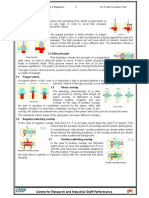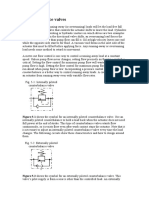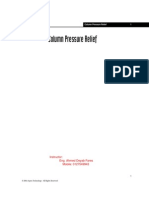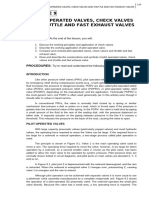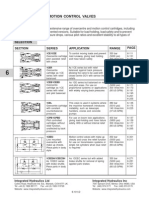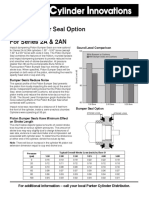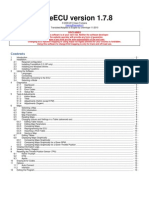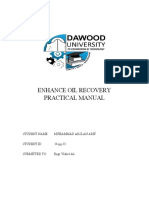Counterbalance Technical
Counterbalance Technical
Uploaded by
Gonzalo AlvarezCopyright:
Available Formats
Counterbalance Technical
Counterbalance Technical
Uploaded by
Gonzalo AlvarezOriginal Description:
Copyright
Available Formats
Share this document
Did you find this document useful?
Is this content inappropriate?
Copyright:
Available Formats
Counterbalance Technical
Counterbalance Technical
Uploaded by
Gonzalo AlvarezCopyright:
Available Formats
Counterbalance Valve
Technical Information
The basic purpose of counterbalance valves is to convert overrunning, or negative loads
into positive loads so that directional control valves always see a positive load. This provides
for safety of the machine and operator.
In Figure 1, when the directional control valve shifts to lower the load, that load starts to
fall out of control as gravity takes over. The load may fall faster than oil can be supplied by the
pump and a vacuum will be create behind the piston. This could draw air through the pump
into the blind end of the cylinder.
V1 C1
PF
Load
Figure 1
By adding a counterbalance valve as shown in Figure 2 to the circuit, we now have a
smooth and shockless way of slowly lowering a heavy load. Sun counterbalance valves are
available in 3:1, 4.5:1 and 10:1 operating ratios. This ratio determines the amount of pilot
pressure required to open the by-pass valve and allow the load to lower.
V1 C1
PF
V2
V3 Load
Figure 2
Figure 3 shows the formula that calculates the amount of pilot pressure required to open
the counterbalance valve.
P = Pilot pressure required to Lower Load
L = Load induced pressure
SL
S = Setting of the valve P=
PR + C R
PR = Pilot ratio of valve
CR = Cylinder area ratio
Figure 3
In general, lower pilot ratios provide better motion control and stability, especially in
spongy systems and in systems with high inertial loads. High pilot ratios generally provide
adequate control of motors, although hydraulically released brakes should still be used to lock
static loads due to motor leakage. High pilot ratios also improve system efficiency through
lower heat generation, but sometimes at the cost of stability and motion control. High ratios
may also be required in systems with very high load induced pressures.
The valve shown in Figure 2 is an internally and externally piloted valve. The external
pilot provides the signal required to open the counterbalance, while the internal pilot provides
the smooth, shockless lowering of massive loads. When external piloting is used, all of the
pump pressure is available when working against static loads. The counterbalance valve may
be drained either externally or internally. However, external draining is preferred, especially
if there are filters, heat exchangers, or other components in the tank return line which could
cause back pressure. With external draining, the spool of the counterbalance valve will already
be in correct counterbalancing position at the moment the directional valve is shifted.
The counterbalance valve setting should be 1.3 times the load induced pressure and this
setting should be made on a test stand if possible.
497
You might also like
- Maintenance Schedule 50 Hour CheckDocument4 pagesMaintenance Schedule 50 Hour Checkraj mohanNo ratings yet
- Pressure Relief Valves PDFDocument6 pagesPressure Relief Valves PDFroyert80No ratings yet
- Controlled ExtractionDocument5 pagesControlled ExtractionNuri Leal100% (4)
- Valve Basics: 1.1 Actuating Force: Centre For Research and Industrial Staff PerformanceDocument6 pagesValve Basics: 1.1 Actuating Force: Centre For Research and Industrial Staff PerformanceSourabh Khandelwal100% (1)
- Overcenter ValvesDocument4 pagesOvercenter ValvesAnonymous jSTkQVC27b100% (1)
- Counterbalance Valve Is Used To Creates A BackDocument3 pagesCounterbalance Valve Is Used To Creates A BackAnakin SkywalkerNo ratings yet
- TT US LoadAdaptive 1Document8 pagesTT US LoadAdaptive 1Iker ArrizabalagaNo ratings yet
- Operation Principle of Counterbalance ValveDocument3 pagesOperation Principle of Counterbalance Valvemihalikj2190100% (1)
- Counterbalance Valves PDFDocument6 pagesCounterbalance Valves PDFlibertyplus100% (1)
- Loadadaptive Counterbalance Valves: CorporationDocument8 pagesLoadadaptive Counterbalance Valves: Corporationfrancis_15inNo ratings yet
- Lecture 19 Fluid Power ControlDocument10 pagesLecture 19 Fluid Power ControlHotib PerwiraNo ratings yet
- Hydraulic Valves - AdvanceDocument17 pagesHydraulic Valves - AdvanceSENANAYAKE S.H.RNo ratings yet
- Experiment 2Document32 pagesExperiment 2Kristine DNo ratings yet
- 1 Basic Hyd CircuitDocument44 pages1 Basic Hyd CircuithamidouNo ratings yet
- Unit 3 - PART 2 OF 3 Control Components in Hydraulic SystemDocument8 pagesUnit 3 - PART 2 OF 3 Control Components in Hydraulic SystemDagnachee TeguNo ratings yet
- Pneumatic, Hydraulic, Electronic ControllersDocument19 pagesPneumatic, Hydraulic, Electronic ControllersNeel DekaNo ratings yet
- IHP Control ValvesDocument22 pagesIHP Control ValvesMayur Madhukar MankarNo ratings yet
- 08 - Column Pressure ReliefDocument10 pages08 - Column Pressure ReliefjeedanNo ratings yet
- Counterbalance Valves: Counterbalance Is A Better Way To Control Running-Away Loads. A Counterbalance KeepsDocument14 pagesCounterbalance Valves: Counterbalance Is A Better Way To Control Running-Away Loads. A Counterbalance KeepsSalah Eldin KararNo ratings yet
- 08 ColumnPressureRelief PDFDocument10 pages08 ColumnPressureRelief PDFtaeebNo ratings yet
- Lecture 17Document16 pagesLecture 17NEELIMA100% (1)
- Pilot Pressure Proportional Control (PPC)Document20 pagesPilot Pressure Proportional Control (PPC)doan luc100% (5)
- Stepless Variable Capacity ControlDocument7 pagesStepless Variable Capacity Controlswapneel_kulkarniNo ratings yet
- Hydraulic Circuit Design and analysis-PPT - Presentation PDFDocument38 pagesHydraulic Circuit Design and analysis-PPT - Presentation PDFTadesse Abadi100% (2)
- Pressure ControlDocument12 pagesPressure ControlMohamed RashedNo ratings yet
- 1.1.1 Functions of Flow-Control ValvesDocument24 pages1.1.1 Functions of Flow-Control Valvesatashi baran mohantyNo ratings yet
- Centre For Research and Industrial Staff PerformanceDocument4 pagesCentre For Research and Industrial Staff PerformanceSourabh KhandelwalNo ratings yet
- Hydraulic and Pneumatic Actuating SystemsDocument10 pagesHydraulic and Pneumatic Actuating SystemsKishanprasad GunaleNo ratings yet
- Hidraulica Taller de InvestigacionDocument19 pagesHidraulica Taller de Investigaciondiego azael cime canulNo ratings yet
- Part 2Document13 pagesPart 2mohammedNo ratings yet
- Pressure Drop Across Proportional ValveDocument4 pagesPressure Drop Across Proportional ValvepalanimechNo ratings yet
- MODULE 9 - Pilot-Operated ValvesDocument12 pagesMODULE 9 - Pilot-Operated ValvesKEERAKYRYL MAGAWAYNo ratings yet
- Study and Testing of PRVDocument4 pagesStudy and Testing of PRVBhargava S PadmashaliNo ratings yet
- Chapter 16: Reducing Valves: What Is in This Article?Document21 pagesChapter 16: Reducing Valves: What Is in This Article?AmitabhaNo ratings yet
- Null 4Document47 pagesNull 4mukhtarnefo97No ratings yet
- Understanding The Unloading Compensator, Part 2Document5 pagesUnderstanding The Unloading Compensator, Part 2s bNo ratings yet
- DesignRules For HighDampingDocument8 pagesDesignRules For HighDampingRajesh MalikNo ratings yet
- Sequencing of CylindresDocument5 pagesSequencing of CylindreschtganduNo ratings yet
- AntisurgeDocument6 pagesAntisurgesch203100% (1)
- Pressure-Control Valves PDFDocument15 pagesPressure-Control Valves PDFRagab Abulmagd100% (1)
- Deal With The Function of The Pressure Control Valves in Hydraulic Power SystemsDocument6 pagesDeal With The Function of The Pressure Control Valves in Hydraulic Power Systems666667100% (1)
- OpenDocument9 pagesOpenchristian1777No ratings yet
- Flow Control ValvesDocument24 pagesFlow Control Valvesmk_chandru100% (1)
- Operating Instructions Pressure Controller Type ROBOTER": 1. Function 1.1Document2 pagesOperating Instructions Pressure Controller Type ROBOTER": 1. Function 1.1shob1984No ratings yet
- EEA 430 Lecture 03 Pneumatic HydraulicsystemsB 06102023 115639amDocument5 pagesEEA 430 Lecture 03 Pneumatic HydraulicsystemsB 06102023 115639amSYED ALIYYAN IMRAN ALINo ratings yet
- Carter Yf Servicing and Adjustment Carter YF CarburetorsDocument4 pagesCarter Yf Servicing and Adjustment Carter YF CarburetorsEdwinferNo ratings yet
- V S C Sec C Cte Ve Va: Pressure Control ValvesDocument13 pagesV S C Sec C Cte Ve Va: Pressure Control Valvesfrederick alayonNo ratings yet
- TransmisionDocument6 pagesTransmisionronal79No ratings yet
- Fluidbasics Chapter14Document11 pagesFluidbasics Chapter14asNo ratings yet
- Hydraulic Valves 2019Document17 pagesHydraulic Valves 2019yusef7138No ratings yet
- Assignment No 3 IHPDocument6 pagesAssignment No 3 IHPJaid KhanNo ratings yet
- Load Sensing ControlDocument2 pagesLoad Sensing ControlMSc Kostic Milos100% (2)
- ! CEB Over Centre Cartridge ValveDocument75 pages! CEB Over Centre Cartridge ValvekmstamimNo ratings yet
- Anti Surge ControlDocument7 pagesAnti Surge Controlachueth100% (3)
- Distillation Column PressureDocument18 pagesDistillation Column PressureSaidFerdjallahNo ratings yet
- Compressor Couse Material Chapter 11Document6 pagesCompressor Couse Material Chapter 11Zahid AchwatoNo ratings yet
- Basics of Pressure RegulationDocument18 pagesBasics of Pressure Regulationar174_569868987No ratings yet
- FAQ-Lecture 24 To 26Document11 pagesFAQ-Lecture 24 To 26sandeepNo ratings yet
- Sequence ValveDocument8 pagesSequence Valvemr3478No ratings yet
- The Petrol Engine: A Text-book dealing with the Principles of Design and Construction, with a Special Chapter on the Two-stroke EngineFrom EverandThe Petrol Engine: A Text-book dealing with the Principles of Design and Construction, with a Special Chapter on the Two-stroke EngineNo ratings yet
- Piping and Wiring To The End Effector: WarningDocument26 pagesPiping and Wiring To The End Effector: WarningGonzalo AlvarezNo ratings yet
- 02L Lubricator - MiniatureDocument1 page02L Lubricator - MiniatureGonzalo AlvarezNo ratings yet
- Quikrete Guide Specification: Quikrete® Concrete Bonding Adhesive (No. 9902)Document3 pagesQuikrete Guide Specification: Quikrete® Concrete Bonding Adhesive (No. 9902)Gonzalo AlvarezNo ratings yet
- Data - Sheet-Concrete Bonding Adhesive 9902 PDFDocument2 pagesData - Sheet-Concrete Bonding Adhesive 9902 PDFGonzalo AlvarezNo ratings yet
- Data - Sheet Qmax Pro 1004 81 PDFDocument2 pagesData - Sheet Qmax Pro 1004 81 PDFGonzalo AlvarezNo ratings yet
- BOOK 2, CHAPTER 1 - Hydraulic Accumulators (Part 3)Document9 pagesBOOK 2, CHAPTER 1 - Hydraulic Accumulators (Part 3)Gonzalo Alvarez100% (2)
- Piston Bumper Seal Option Now Available For Series 2A & 2AN: Sound Level ComparisonDocument2 pagesPiston Bumper Seal Option Now Available For Series 2A & 2AN: Sound Level ComparisonGonzalo AlvarezNo ratings yet
- Grass Trimmer/Brush Cutter: Operator's ManualDocument36 pagesGrass Trimmer/Brush Cutter: Operator's ManualGonzalo AlvarezNo ratings yet
- 16931211Document236 pages16931211Gonzalo AlvarezNo ratings yet
- E13100 0 09 10 - MaschR PDFDocument32 pagesE13100 0 09 10 - MaschR PDFGonzalo Alvarez100% (1)
- Aircraft Piston Engine DocumentDocument12 pagesAircraft Piston Engine DocumentArulBala0% (1)
- Anatomy of The Mud Pump Pul...Document6 pagesAnatomy of The Mud Pump Pul...Mugisha Allan100% (1)
- Renewable EnergyDocument25 pagesRenewable EnergySharad KumarNo ratings yet
- CNG Cylinder Design and SafetyDocument53 pagesCNG Cylinder Design and SafetyMartha GamalNo ratings yet
- 13OBDG09 Engine DiagnosticsDocument562 pages13OBDG09 Engine DiagnosticsEric Joseph GoldenNo ratings yet
- Theory of MachinesDocument14 pagesTheory of MachinesGourav KotriwarNo ratings yet
- Generac Power SystemsDocument68 pagesGenerac Power Systemsprinter6No ratings yet
- Caterpillar Crawler Service Manual CT S D747a3396Document15 pagesCaterpillar Crawler Service Manual CT S D747a3396martenstupa90No ratings yet
- Mercury Cooling System ComponentsDocument9 pagesMercury Cooling System ComponentswguenonNo ratings yet
- Site VisitDocument10 pagesSite VisitAhmadNo ratings yet
- Hyundai Robex r80-7 Service ManualDocument409 pagesHyundai Robex r80-7 Service Manualye htikeNo ratings yet
- Generador APD550PEDocument4 pagesGenerador APD550PEFTL1990No ratings yet
- Alist2Document56 pagesAlist2jigar00775No ratings yet
- DTSI Techonology Seminar Report For Rite CollegeDocument21 pagesDTSI Techonology Seminar Report For Rite Collegesurjit kumar sahoo82% (17)
- Question Paper Code:: Reg. No.Document2 pagesQuestion Paper Code:: Reg. No.Jagadish Babu KondraguntaNo ratings yet
- Flow Control Valves Pressure Compensated Cartridge TypeDocument6 pagesFlow Control Valves Pressure Compensated Cartridge TypevrgohilNo ratings yet
- TuneECU 1.7.8 EnglishDocument13 pagesTuneECU 1.7.8 Englishamolea1974No ratings yet
- Wartsila Liquid Biofuel PlantsDocument12 pagesWartsila Liquid Biofuel Plantsrvm1010No ratings yet
- AP 1000 ReactorDocument10 pagesAP 1000 ReactorKhaled Reda100% (1)
- YAK-52 Operating HandbookDocument12 pagesYAK-52 Operating HandbookaturcubbNo ratings yet
- Null 221218 024522Document2 pagesNull 221218 024522Imam GozaliNo ratings yet
- L100N Cylinder Parts Yanmar PDFDocument10 pagesL100N Cylinder Parts Yanmar PDFjetdedeNo ratings yet
- LNG, CNG, LPG, NGLDocument6 pagesLNG, CNG, LPG, NGLshuvo134No ratings yet
- Eor Manual 32 PDFDocument19 pagesEor Manual 32 PDFarslansamarNo ratings yet
- 4-Economics MCQ Part PDFDocument13 pages4-Economics MCQ Part PDFAhmadNo ratings yet
- Lsy33s3 6Document6 pagesLsy33s3 6JaiderNo ratings yet
- E101 3235 IK 555 Sootblower PDFDocument4 pagesE101 3235 IK 555 Sootblower PDFTaQuangDucNo ratings yet
- Cummins EA - T - CC - 27 - EN Specification Sheet Q50 (0623)Document4 pagesCummins EA - T - CC - 27 - EN Specification Sheet Q50 (0623)Derek OngNo ratings yet
- 77-9075 DD5Document72 pages77-9075 DD5Imad AghilaNo ratings yet



